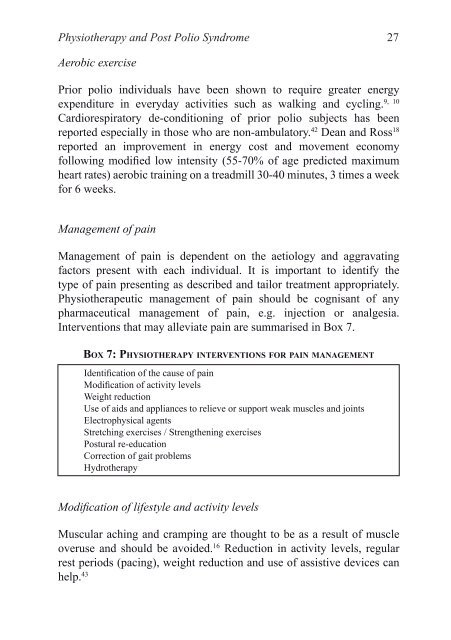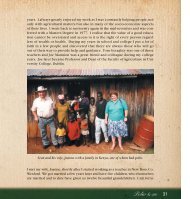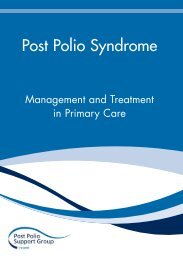Post Polio Syndrome - Management & Treatment in Primary
Post Polio Syndrome - Management & Treatment in Primary
Post Polio Syndrome - Management & Treatment in Primary
Create successful ePaper yourself
Turn your PDF publications into a flip-book with our unique Google optimized e-Paper software.
Physiotherapy and <strong>Post</strong> <strong>Polio</strong> <strong>Syndrome</strong> 27<br />
Aerobic exercise<br />
Prior polio <strong>in</strong>dividuals have been shown to require greater energy<br />
9, 10<br />
expenditure <strong>in</strong> everyday activities such as walk<strong>in</strong>g and cycl<strong>in</strong>g.<br />
Cardiorespiratory de-condition<strong>in</strong>g of prior polio subjects has been<br />
reported especially <strong>in</strong> those who are non-ambulatory. 42 Dean and Ross18 reported an improvement <strong>in</strong> energy cost and movement economy<br />
follow<strong>in</strong>g modified low <strong>in</strong>tensity (55-70% of age predicted maximum<br />
heart rates) aerobic tra<strong>in</strong><strong>in</strong>g on a treadmill 30-40 m<strong>in</strong>utes, 3 times a week<br />
for 6 weeks.<br />
<strong>Management</strong> of pa<strong>in</strong><br />
<strong>Management</strong> of pa<strong>in</strong> is dependent on the aetiology and aggravat<strong>in</strong>g<br />
factors present with each <strong>in</strong>dividual. It is important to identify the<br />
type of pa<strong>in</strong> present<strong>in</strong>g as described and tailor treatment appropriately.<br />
Physiotherapeutic management of pa<strong>in</strong> should be cognisant of any<br />
pharmaceutical management of pa<strong>in</strong>, e.g. <strong>in</strong>jection or analgesia.<br />
Interventions that may alleviate pa<strong>in</strong> are summarised <strong>in</strong> Box 7.<br />
box 7: PhysiotheraPy <strong>in</strong>terventions For Pa<strong>in</strong> management<br />
Identification of the cause of pa<strong>in</strong><br />
Modification of activity levels<br />
Weight reduction<br />
Use of aids and appliances to relieve or support weak muscles and jo<strong>in</strong>ts<br />
Electrophysical agents<br />
Stretch<strong>in</strong>g exercises / Strengthen<strong>in</strong>g exercises<br />
<strong>Post</strong>ural re-education<br />
Correction of gait problems<br />
Hydrotherapy<br />
Modification of lifestyle and activity levels<br />
Muscular ach<strong>in</strong>g and cramp<strong>in</strong>g are thought to be as a result of muscle<br />
overuse and should be avoided. 16 Reduction <strong>in</strong> activity levels, regular<br />
rest periods (pac<strong>in</strong>g), weight reduction and use of assistive devices can<br />
help. 43<br />
PPS Mngt and Treat.<strong>in</strong>db 27 02/07/2007 16:07:51





